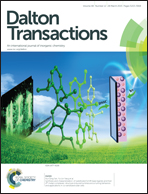A novel synthetic route to transition metal phosphide nanoparticles
Abstract
A novel synthetic route was developed to prepare nano-sized and well-dispersed phosphides of transition metals (Mo, Ni, and Co) from their corresponding oxide precursors. The current approach produced metal phosphides in dimethyl ether (DME) using the rapid heating reduction (RHR) method. The synthesis of phosphides in DME was interesting, since the composition of gas-phase products was predominantly H2, CO and CH4 with a minor amount of CO2 but without H2O. Based on XRD and MS results, the formation mechanism of the phosphides was proposed. The overall synthesis process cannot simply be regarded as the reduction of an oxide precursor and the decomposition of DME. The product distribution should be ascribed to a combination of other catalytic reactions. In addition, it is noteworthy that compared with the traditional method, viz. temperature-programmed reduction in H2 (TPR-H2), the present method used a higher heating rate to shorten the reaction time and can yield more finely dispersed metal phosphide nanoparticles. The good dispersion of phosphide nanoparticles is probably achieved due to the fact that no H2O was released in the RHR-DME process, which can avoid strong hydrothermal sintering.


 Please wait while we load your content...
Please wait while we load your content...